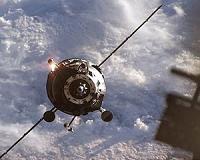 |
Paris, France (ESA) Feb 04, 2011 ESA's latest Automated Transfer Vehicle is ready for launch to the International Space Station on Tuesday, 15 February at 22:08 GMT from Europe's Spaceport in Kourou, French Guiana. The unmanned spaceship will deliver essential supplies and reboost the Station during its mission lasting three and half months. The launch will be covered live from Kourou for broadcasters and on the Web, and celebrated at a launch event in Bremen, Germany. Europe's second ATV Johannes Kepler is the first operational ATV, following the highly successful Jules Verne qualification flight in 2008. With a total mass of over 20 tonnes, it is the heaviest payload ever launched by Europe. ATV is a highly sophisticated spacecraft, combining an autonomous free-flying platform, a manoeuvrable space vehicle and - when docked - a space station module. To achieve an automated docking under the very tight safety constraints imposed by human spaceflight rules, ATV carries high-precision navigation systems, highly redundant flight software and a fully autonomous collision-avoidance system with its own independent power supplies, control and thrusters. About 10 m high with a diameter of 4.5 m, ATV includes a 45-cubic m pressurised module and a Russian docking system, similar to those used on the Soyuz manned ferries and the Progress resupply ships. With its solar wings deployed, ATV spans 22 m. Almost three times larger than Russia's Progress, it can also deliver about three times the cargo load.
Propellant and cargo for the ISS Once docked to the ISS, this propellant will be used by ATV's own thrusters to raise the Station's orbit periodically in order to compensate for the natural decay caused by atmospheric drag. It may also be used to move the ISS out of the way of potentially dangerous space debris that comes too close to the manned space complex. ATV's payload includes almost 1600 kg of dry cargo, 850 kg of propellant for Russia's Zvezda module and 100 kg of oxygen. Before leaving the ISS, in June, Johannes Kepler will be filled with waste bags and unwanted hardware by the crew. It will then be deorbited over the Southern Pacific Ocean and perform a controlled reentry to burn up harmlessly in the atmosphere. Exceptionally, no drinking water will be delivered because there is already plenty aboard the ISS. The water tanks will, though, be filled with liquid waste from the Station before departure. ATV Johannes Kepler is named after the famous German astronomer and mathematician who lived in the 16th and 17th centuries. He first depicted the movement of planetary bodies in elliptical orbits, thus paving the way for Isaac Newton's theory of gravitation. It is the second in a series of five spaceships developed as Europe's contribution to the operational costs of the ISS. Astrium Space Transportation is prime industrial contractor, leading a team of more than 30 contractors in 10 European countries.
Share This Article With Planet Earth
Related Links Follow the ATV-2 mission Station at NASA Station and More at Roscosmos S.P. Korolev RSC Energia Watch NASA TV via Space.TV Space Station News at Space-Travel.Com
 Russian Space Freighter Progress M-09M Docks With ISS
Russian Space Freighter Progress M-09M Docks With ISSMission Control, Russia (RIA Novosti) Jan 31, 2011 A Russian cargo spacecraft, Progress M-09M, docked on Sunday with the International Space Station (ISS). A Soyuz-U booster rocket carrying the spacecraft blasted off from the Baikonur space center in Kazakhstan on Friday. The space freighter delivered fuel, oxygen, food, books and birthday presents for Expedition 26 captain Scott J. Kelly of the United States, who turns 47 on Februar ... read more |
|
| The content herein, unless otherwise known to be public domain, are Copyright 1995-2010 - SpaceDaily. AFP and UPI Wire Stories are copyright Agence France-Presse and United Press International. ESA Portal Reports are copyright European Space Agency. All NASA sourced material is public domain. Additional copyrights may apply in whole or part to other bona fide parties. Advertising does not imply endorsement,agreement or approval of any opinions, statements or information provided by SpaceDaily on any Web page published or hosted by SpaceDaily. Privacy Statement |